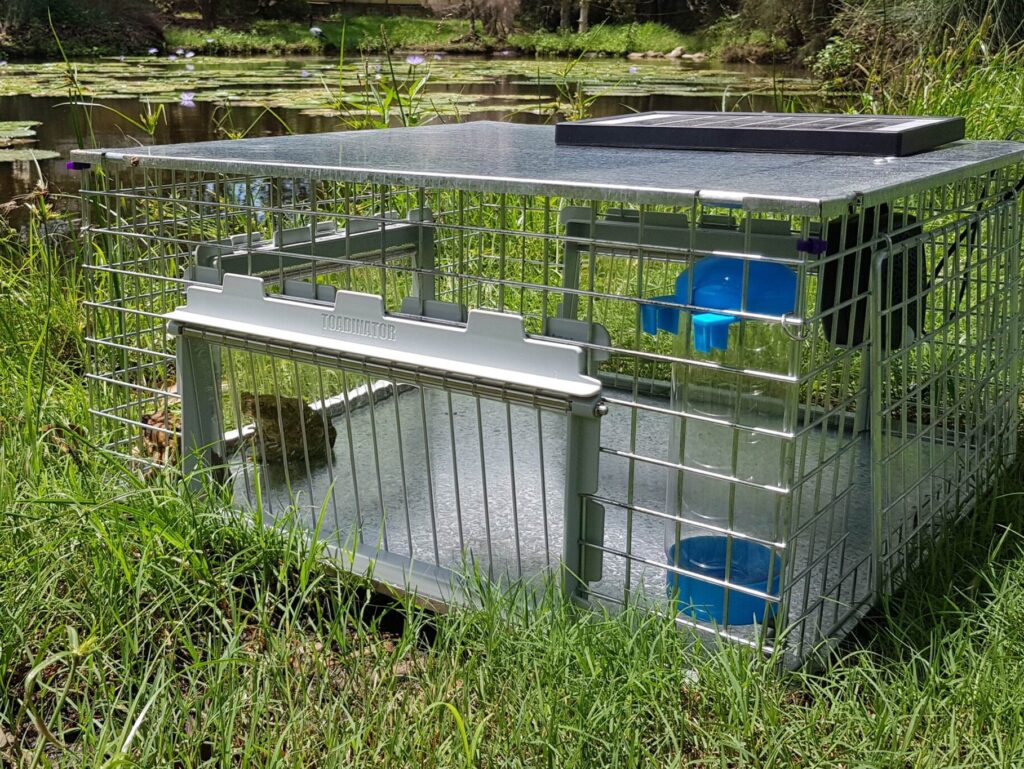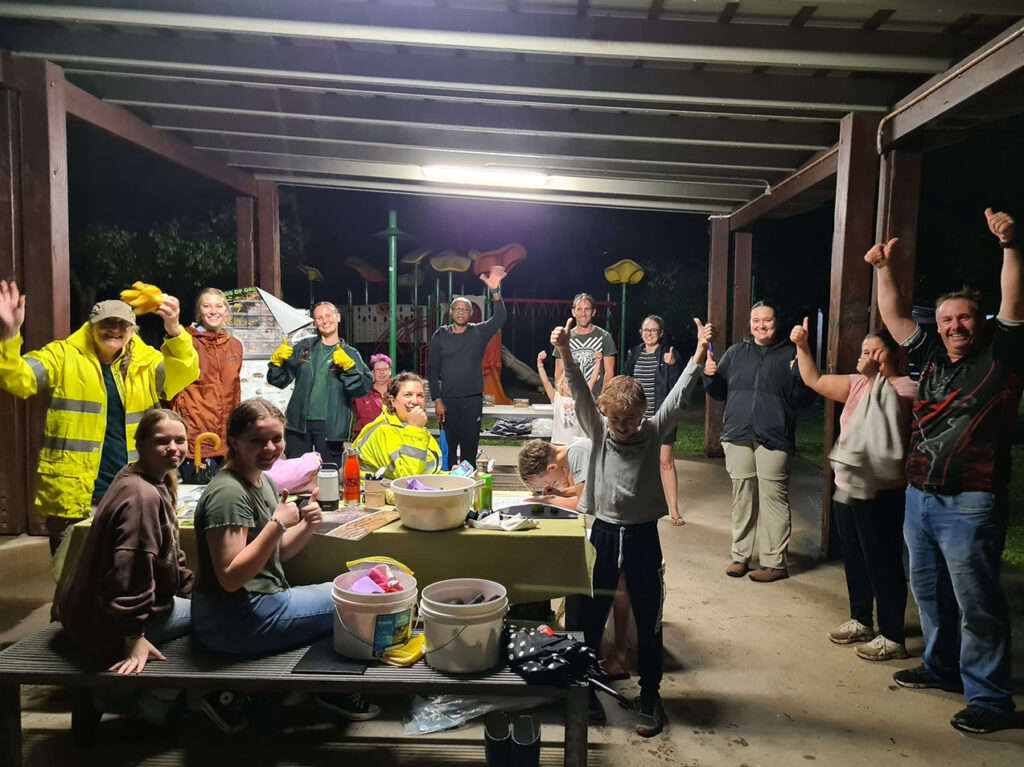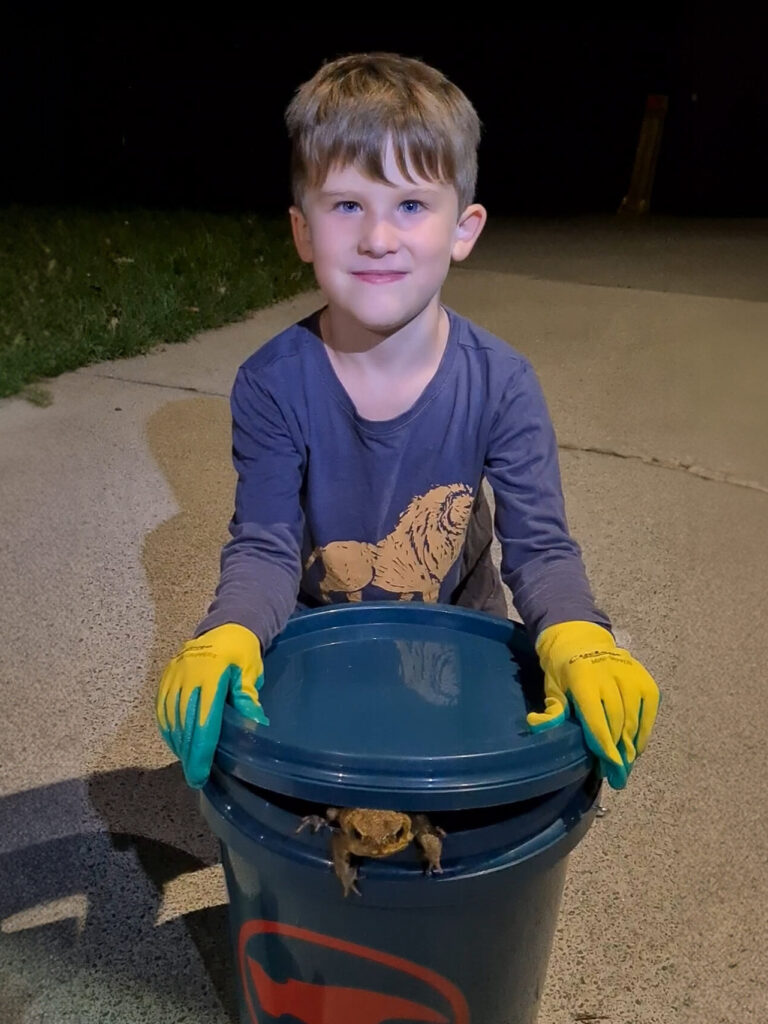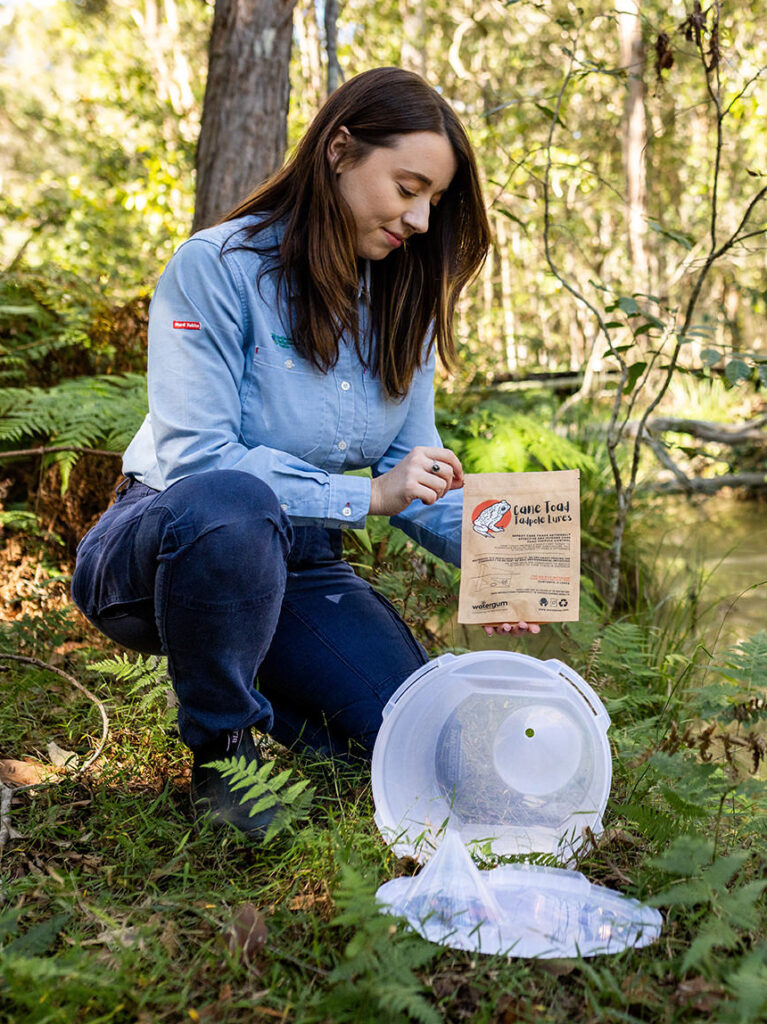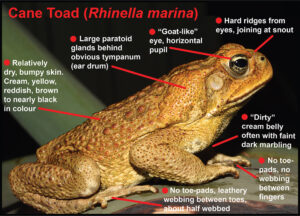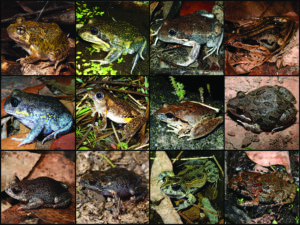The introduction of the Cane Toad in 1935 to Australia to control agricultural pests brought a whole range of negative impacts into our natural environment and our wildlife. Cane Toads are continuing to spread across the landscape and there is no sign of reprieve. If we are to attack this problem head on, we all need to collaborate and reduce numbers in our own backyards.
In Queensland, everyone has a general biosecurity obligation under the law to take reasonable and practical steps to minimise the risks associated with invasive animals under their control. Here are some tips on how to do this.
You can toad bust in your own patch and make a real dint in the toad population. Within a short period of time, you should see a decrease in Cane Toad numbers and an increase in frog numbers.
Humane disposal of toads is essential. After collecting toads, it is recommended to follow the stepped hypothermia method. This involves placing the toads in a container in the fridge for 12 hours followed by placing them in the freezer for a further 24 hours, then placing them in the bin, on bin day.
Remember Cane Toads have poisonous glands, so if you are handling them, you must wear appropriate personal protective equipment like surgical gloves. Also, please keep your pets safe and do not allow them to have access to Cane Toads. It isn’t just the large paratoid gland on adult toads that contains toxins, even dried out toad eggs and tadpoles also contain toxins. These toxins, if ingested by pets or wildlife, can affect the nervous system, heart and gastrointestinal tract, and can be fatal if eaten in large amounts. If you suspect that your pet has eaten large amounts of toad material, it is best to get them to a vet as soon as possible.
Redland City Council (RCC) is toadally excited and in the planning stage for their third year of Cane Toad education and busting. Over the last two years RCC has held workshops for the community in collaboration with Watergum. These talks were followed by toad busting events held at Capalaba and Mount Cotton. These events were all well attended, and the results spoke for themselves with 2,020 Cane Toads removed from the environment. We have participants who tell us they can’t wait to join us again for the third year running.
Many participants have installed a toad-proof frog pond or frog hotel and it doesn’t take too long before they are inhabited with native frogs.
We have been working with private property owners across the Redlands for 24 years though our Environmental Partnerships Programs such as Land for Wildlife. We have found that the best control method for pest management is integrated control using multiple approaches. The following is a four-stage control program that has been proven to reduce Cane Toad and tadpole numbers and increase frog numbers.
1. Creation of a thick planted barrier to prevent toads from breeding in waterways/waterbodies
Working in partnership with landholders, we have managed to increase the native vegetation surrounding a large number of water bodies. By creating a thick vegetated buffer, we are keeping the Cane Toads out of the water body where they would otherwise reproduce. This practice has also shown to significantly increase habitat for aquatic/terrestrial wildlife and has improved water quality.
2. Regular collection and disposal of toad eggs
Cane Toad eggs will hatch within two or three days. We recommend to all our participants that they regularly check their dams for toad eggs (look for small black eggs in long, clear, jellylike strands), and remove them out of the environment and place them away from wildlife and pets.
3. Regular collection and disposal of tadpoles
Female Cane Toads can produce up to 70,000 tadpoles per year. The tadpole stage of the life cycle lasts 4-8 weeks. The third part of an integrated control program is the use of funnel traps and lures. The lures are made from toxic Cane Toad glands to attract toad tadpoles that are drawn to the chemical attractant released from the lures. The traps are placed in shallow water where the toad tadpoles congregate. One lure can attract thousands of tadpoles in just a few hours.
RCC, and several other Local Governments in SEQ, have purchased a number of tadpole traps to loan out to Land for Wildlife members upon request. Please check with your Land for Wildlife Officer if you would like to borrow a toad trap. Alternatively, you can purchase the funnel traps and lures yourself from Watergum via https://watergum.org/canetoads/.
4. Regular collection and disposal of adult toads
Regular collection of adult Cane Toads can be undertaken in a few different ways. It is surprising just how quickly toad numbers can be reduced by manual collection on small properties. For some years now, RCC has been purchasing and loaning out Toadinator traps to landholders who have had good success in capturing juvenile and adult toads with very little effort. One participant collected over 200 Cane Toads in just one night.
Toadinator traps are designed to attract and catch adult female Cane Toads, which can then be removed and disposed of humanely. One-way doors on three sides of the trap allow toads to enter but not exit. The traps are solar powered with a light to attract insects and a Cane Toad caller to call in the females. The caller and lights come on at night when toads are most active and then automatically turn off during the day while charging. By attracting female toads into the trap before they lay hundreds of eggs, you are effectively having a bigger impact on toad numbers than catching single Cane Toads.
Australian Control Technologies (Australia) (ACTA) Pty. Ltd. worked with James Cook University to research and test the Toadinator Cane Toad Traps which can now be purchased from ACTA via https://animalcontrol.com.au/products/toadinator.
 The Australian Museum has a fantastic Frog Identification app which is easy to download and use. The Museum is very keen for people to record and submit their frog and Cane Toad calls on this app. This project will assist in adding more frog and toad records to those already mapped and assist in keeping an eye on their populations. The large number of Cane Toads, particularly from September to April, can have a direct impact on native frog populations, as toads compete with frogs for food and suitable breeding locations.
The Australian Museum has a fantastic Frog Identification app which is easy to download and use. The Museum is very keen for people to record and submit their frog and Cane Toad calls on this app. This project will assist in adding more frog and toad records to those already mapped and assist in keeping an eye on their populations. The large number of Cane Toads, particularly from September to April, can have a direct impact on native frog populations, as toads compete with frogs for food and suitable breeding locations.
There are numerous ways in which you can track and manage toads on your property and deter toads from breeding in your dams and other waterbodies, especially using the recently developed traps mentioned above.
Not toads, but similar looking native frogs! Images by Jodi Rowley.
Article and photos by Maree Manby
Land for Wildlife Officer
Redland City Council

